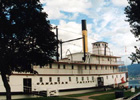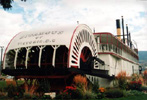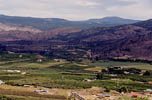 The Ogopogo Country The Ogopogo Country
Penticton
Penticton, as translated by the local Salish Native Americans, means "a place to live forever" (the commonly accepted translation) or "a place to live year-round". Tom Ellis, the first Non-Native settler in the area, took the meaning to heart and settled here in 1865. Tom Ellis, from England, planned the formulation of the new town. In 1892, a townsite was laid out around the Smith Street area. The street is now called Front Street, home to many unique stores and boutiques.
 Smith Street was named after C.S. Smith, who owned a sawmill and supplied much of the lumber used to construct the original buildings. This was home to many buildings that no longer exist, but which then housed the businesses of the day: Livery barns, blacksmiths, barbershops, bakershops, hotels, etc. A strange, little known fact, was that some of the older, wooden buildings were built on skids and could be moved to a new location by simply hitching them up to a team of horses and dragging them away. Smith Street was named after C.S. Smith, who owned a sawmill and supplied much of the lumber used to construct the original buildings. This was home to many buildings that no longer exist, but which then housed the businesses of the day: Livery barns, blacksmiths, barbershops, bakershops, hotels, etc. A strange, little known fact, was that some of the older, wooden buildings were built on skids and could be moved to a new location by simply hitching them up to a team of horses and dragging them away.
By 1907, Penticton had grown to the bountiful size of 600 residents, and was officially recognized by the British Columbia Government as a municipal district. In the teens, the building of the Kettle Valley Railroad increased the population to around 1500 people. By 1921 the city was 4,000 strong, but it took until 1948 for Penticton to gain City Status.
 The early days were difficult for road travel, but with the proliferation of the automobile and the constant increase in poulation, road-building was in full-force by the 1920's. Prior to this, travel was done primarily by water, up and down the Okanagan Lake, which runs from Vernon in the north to its southern tip at Penticton. Much of this travel was aboard the S.S. Sicamous. Although not the first, but probably the most famous stern-wheeler to grace Okanagan Lake, the S.S. Sicamous was known as the Queen of the Lake. She was built in Port Harbour in Ontario and assembled in Okanagan Landing for her maiden voyage on July 1st, also Canada's birthday, in 1914. Many of the servicemen heading for WW1 began their journey aboard the S.S Sicamous. Demoted to carrying freight in 1935, was then retired two fruit seasons later. Penticton purchased her from Canadian Pacific Railway (CPR) in 1949 for $1. The early days were difficult for road travel, but with the proliferation of the automobile and the constant increase in poulation, road-building was in full-force by the 1920's. Prior to this, travel was done primarily by water, up and down the Okanagan Lake, which runs from Vernon in the north to its southern tip at Penticton. Much of this travel was aboard the S.S. Sicamous. Although not the first, but probably the most famous stern-wheeler to grace Okanagan Lake, the S.S. Sicamous was known as the Queen of the Lake. She was built in Port Harbour in Ontario and assembled in Okanagan Landing for her maiden voyage on July 1st, also Canada's birthday, in 1914. Many of the servicemen heading for WW1 began their journey aboard the S.S Sicamous. Demoted to carrying freight in 1935, was then retired two fruit seasons later. Penticton purchased her from Canadian Pacific Railway (CPR) in 1949 for $1.
There have been many historic moments throughout the years. In 1911, Wade's General Store, owned and built by founder  Tom Ellis' brother in Law A.H. Wade, burnt down, never to be replaced. In 1917, women get the well-deserved right to vote. Alcohol becomes illegal in B.C. In 1922, Dave Riordan is in high spirits as his new house is completed. In 1942, most of the city was submerged by a spring flood. In December 1950, Penticton was shocked by a plane crash. In March 1955, the Penticton Vee's Hockey Team brought home the World Cup after defeating the U.S.S.R 5-0. Many changes have come to Penticton. The city now has a population of approximately 33,000 and continues to grow. Still, if you listen hard on a quiet night, you can almost hear the horn of one of the old steamwheelers, announcing its arrival on the beach. Tom Ellis' brother in Law A.H. Wade, burnt down, never to be replaced. In 1917, women get the well-deserved right to vote. Alcohol becomes illegal in B.C. In 1922, Dave Riordan is in high spirits as his new house is completed. In 1942, most of the city was submerged by a spring flood. In December 1950, Penticton was shocked by a plane crash. In March 1955, the Penticton Vee's Hockey Team brought home the World Cup after defeating the U.S.S.R 5-0. Many changes have come to Penticton. The city now has a population of approximately 33,000 and continues to grow. Still, if you listen hard on a quiet night, you can almost hear the horn of one of the old steamwheelers, announcing its arrival on the beach.
|


